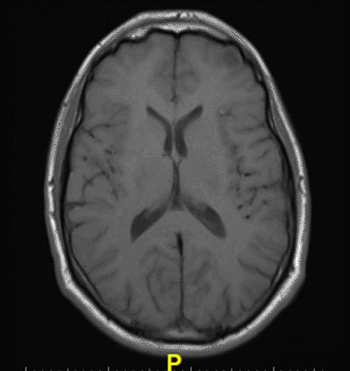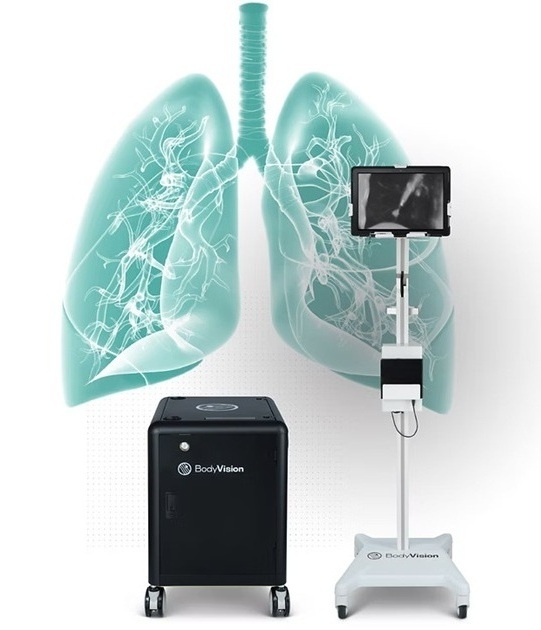Link Between Brain Abnormalities and Gadolinium-Based Contrast Agent
|
By MedImaging International staff writers Posted on 08 Jan 2014 |

Image: A new study raises the possibility that a toxic component of the contrast agent may remain in the body long after administration (Photo courtesy of Radiology).
Researchers for the first time have confirmed an association between a common magnetic resonance imaging (MRI) contrast agent and abnormalities seen on brain MRI scans.
The new findings were published online December 2013 in the journal Radiology, and reveals the possibility that a toxic component of the contrast agent may stay in the body a long time after administration.
Brain MRI scans are frequently performed with a gadolinium-based contrast medium (Gd-CM). Gadolinium’s paramagnetic properties make it useful for MRI scanning, however, because of the toxicity of the gadolinium ion, it must be chemically bonded with nonmetal ions so that it can be moved through the kidneys and out of the body before the ion is released in tissue. Gd-CM is believed to be safe in patients with normal kidney function.
However, in recently, Japanese clinicians noticed that patients with a history of multiple administrations of Gd-CM showed areas of high intensity (hyperintensity) on MRI in two brain areas: the dentate nucleus (DN) and globus pallidus (GP). The specific clinical implications of hyperintensity are not known, but hyperintensity in the DN has been linked with multiple sclerosis, while hyperintensity of the GP is associated with hepatic dysfunction and several disorders.
The investigators compared unenhanced T1-weighted MR images (T1WI) of 19 patients who had undergone six or more contrast-enhanced MR brain scanning with 16 patients who had received six or fewer unenhanced scans. The hyperintensity of both the DN and the GP correlated with the number of Gd-CM administrations.
“Hyperintensity in the DN and GP on unenhanced MRI may be a consequence of the number of previous Gd-CM administrations,” said lead author Tomonori Kanda, MD, PhD, from Teikyo University School of Medicine (Tokyo, Japan) and the Hyogo Cancer Center (Akashi, Japan). “Because gadolinium has a high signal intensity in the body, our data may suggest that the toxic gadolinium component remains in the body even in patients with normal renal function.”
Dr. Kanda noted that because patients with multiple sclerosis tend to undergo numerous contrast-enhanced brain MRI scans, the hyperintensity of the DN seen in these patients may have more to do with the large cumulative gadolinium dose than the disease itself.
The processes by which Gd-CM administration causes hyperintensity of the DN and GP remain not known, according to Dr. Kanda. Earlier research on animals and humans has demonstrated that the ion can be kept in bone and tissue for several days or longer after administration. “The hyperintensity of DN and GP on unenhanced T1WI may be due to gadolinium deposition in the brain independent of renal function, and the deposition may remain in the brain for a long time,” Dr. Kanda suggested.
Dr. Kanda emphasized that there is currently no evidence that gadolinium is responsible for hyperintensity on brain MRI scans. Additional studies gleaned from autopsy specimens and animal experiments will be needed to illuminate the relationship and determine if the patients with MRI hyperintensity in their brains have symptoms. “Because patients who have multiple contrast material injections tend to have severe diseases, a slight symptom from the gadolinium ion may be obscured,” Dr. Kanda said.
There are two types of Gd-CM, macrocyclic and linear, with distinct chemical configurations. Because the patients in the study received only the linear type, additional research is needed to see if the macrocyclic type can prevent MRI hyperintensity, according to Dr. Kanda.
Related Links:
Teikyo University School of Medicine
The new findings were published online December 2013 in the journal Radiology, and reveals the possibility that a toxic component of the contrast agent may stay in the body a long time after administration.
Brain MRI scans are frequently performed with a gadolinium-based contrast medium (Gd-CM). Gadolinium’s paramagnetic properties make it useful for MRI scanning, however, because of the toxicity of the gadolinium ion, it must be chemically bonded with nonmetal ions so that it can be moved through the kidneys and out of the body before the ion is released in tissue. Gd-CM is believed to be safe in patients with normal kidney function.
However, in recently, Japanese clinicians noticed that patients with a history of multiple administrations of Gd-CM showed areas of high intensity (hyperintensity) on MRI in two brain areas: the dentate nucleus (DN) and globus pallidus (GP). The specific clinical implications of hyperintensity are not known, but hyperintensity in the DN has been linked with multiple sclerosis, while hyperintensity of the GP is associated with hepatic dysfunction and several disorders.
The investigators compared unenhanced T1-weighted MR images (T1WI) of 19 patients who had undergone six or more contrast-enhanced MR brain scanning with 16 patients who had received six or fewer unenhanced scans. The hyperintensity of both the DN and the GP correlated with the number of Gd-CM administrations.
“Hyperintensity in the DN and GP on unenhanced MRI may be a consequence of the number of previous Gd-CM administrations,” said lead author Tomonori Kanda, MD, PhD, from Teikyo University School of Medicine (Tokyo, Japan) and the Hyogo Cancer Center (Akashi, Japan). “Because gadolinium has a high signal intensity in the body, our data may suggest that the toxic gadolinium component remains in the body even in patients with normal renal function.”
Dr. Kanda noted that because patients with multiple sclerosis tend to undergo numerous contrast-enhanced brain MRI scans, the hyperintensity of the DN seen in these patients may have more to do with the large cumulative gadolinium dose than the disease itself.
The processes by which Gd-CM administration causes hyperintensity of the DN and GP remain not known, according to Dr. Kanda. Earlier research on animals and humans has demonstrated that the ion can be kept in bone and tissue for several days or longer after administration. “The hyperintensity of DN and GP on unenhanced T1WI may be due to gadolinium deposition in the brain independent of renal function, and the deposition may remain in the brain for a long time,” Dr. Kanda suggested.
Dr. Kanda emphasized that there is currently no evidence that gadolinium is responsible for hyperintensity on brain MRI scans. Additional studies gleaned from autopsy specimens and animal experiments will be needed to illuminate the relationship and determine if the patients with MRI hyperintensity in their brains have symptoms. “Because patients who have multiple contrast material injections tend to have severe diseases, a slight symptom from the gadolinium ion may be obscured,” Dr. Kanda said.
There are two types of Gd-CM, macrocyclic and linear, with distinct chemical configurations. Because the patients in the study received only the linear type, additional research is needed to see if the macrocyclic type can prevent MRI hyperintensity, according to Dr. Kanda.
Related Links:
Teikyo University School of Medicine
Latest MRI News
- New MRI Technique Reveals Hidden Heart Issues
- Shorter MRI Exam Effectively Detects Cancer in Dense Breasts
- MRI to Replace Painful Spinal Tap for Faster MS Diagnosis
- MRI Scans Can Identify Cardiovascular Disease Ten Years in Advance
- Simple Brain Scan Diagnoses Parkinson's Disease Years Before It Becomes Untreatable
- Cutting-Edge MRI Technology to Revolutionize Diagnosis of Common Heart Problem
- New MRI Technique Reveals True Heart Age to Prevent Attacks and Strokes
- AI Tool Predicts Relapse of Pediatric Brain Cancer from Brain MRI Scans
- AI Tool Tracks Effectiveness of Multiple Sclerosis Treatments Using Brain MRI Scans
- Ultra-Powerful MRI Scans Enable Life-Changing Surgery in Treatment-Resistant Epileptic Patients
- AI-Powered MRI Technology Improves Parkinson’s Diagnoses
- Biparametric MRI Combined with AI Enhances Detection of Clinically Significant Prostate Cancer
- First-Of-Its-Kind AI-Driven Brain Imaging Platform to Better Guide Stroke Treatment Options
- New Model Improves Comparison of MRIs Taken at Different Institutions
- Groundbreaking New Scanner Sees 'Previously Undetectable' Cancer Spread
- First-Of-Its-Kind Tool Analyzes MRI Scans to Measure Brain Aging
Channels
Radiography
view channel
Machine Learning Algorithm Identifies Cardiovascular Risk from Routine Bone Density Scans
A new study published in the Journal of Bone and Mineral Research reveals that an automated machine learning program can predict the risk of cardiovascular events and falls or fractures by analyzing bone... Read more
AI Improves Early Detection of Interval Breast Cancers
Interval breast cancers, which occur between routine screenings, are easier to treat when detected earlier. Early detection can reduce the need for aggressive treatments and improve the chances of better outcomes.... Read more
World's Largest Class Single Crystal Diamond Radiation Detector Opens New Possibilities for Diagnostic Imaging
Diamonds possess ideal physical properties for radiation detection, such as exceptional thermal and chemical stability along with a quick response time. Made of carbon with an atomic number of six, diamonds... Read moreUltrasound
view channel
New Incision-Free Technique Halts Growth of Debilitating Brain Lesions
Cerebral cavernous malformations (CCMs), also known as cavernomas, are abnormal clusters of blood vessels that can grow in the brain, spinal cord, or other parts of the body. While most cases remain asymptomatic,... Read more.jpeg)
AI-Powered Lung Ultrasound Outperforms Human Experts in Tuberculosis Diagnosis
Despite global declines in tuberculosis (TB) rates in previous years, the incidence of TB rose by 4.6% from 2020 to 2023. Early screening and rapid diagnosis are essential elements of the World Health... Read moreNuclear Medicine
view channel
New Imaging Approach Could Reduce Need for Biopsies to Monitor Prostate Cancer
Prostate cancer is the second leading cause of cancer-related death among men in the United States. However, the majority of older men diagnosed with prostate cancer have slow-growing, low-risk forms of... Read more
Novel Radiolabeled Antibody Improves Diagnosis and Treatment of Solid Tumors
Interleukin-13 receptor α-2 (IL13Rα2) is a cell surface receptor commonly found in solid tumors such as glioblastoma, melanoma, and breast cancer. It is minimally expressed in normal tissues, making it... Read moreGeneral/Advanced Imaging
view channel
First-Of-Its-Kind Wearable Device Offers Revolutionary Alternative to CT Scans
Currently, patients with conditions such as heart failure, pneumonia, or respiratory distress often require multiple imaging procedures that are intermittent, disruptive, and involve high levels of radiation.... Read more
AI-Based CT Scan Analysis Predicts Early-Stage Kidney Damage Due to Cancer Treatments
Radioligand therapy, a form of targeted nuclear medicine, has recently gained attention for its potential in treating specific types of tumors. However, one of the potential side effects of this therapy... Read moreImaging IT
view channel
New Google Cloud Medical Imaging Suite Makes Imaging Healthcare Data More Accessible
Medical imaging is a critical tool used to diagnose patients, and there are billions of medical images scanned globally each year. Imaging data accounts for about 90% of all healthcare data1 and, until... Read more
Global AI in Medical Diagnostics Market to Be Driven by Demand for Image Recognition in Radiology
The global artificial intelligence (AI) in medical diagnostics market is expanding with early disease detection being one of its key applications and image recognition becoming a compelling consumer proposition... Read moreIndustry News
view channel
GE HealthCare and NVIDIA Collaboration to Reimagine Diagnostic Imaging
GE HealthCare (Chicago, IL, USA) has entered into a collaboration with NVIDIA (Santa Clara, CA, USA), expanding the existing relationship between the two companies to focus on pioneering innovation in... Read more
Patient-Specific 3D-Printed Phantoms Transform CT Imaging
New research has highlighted how anatomically precise, patient-specific 3D-printed phantoms are proving to be scalable, cost-effective, and efficient tools in the development of new CT scan algorithms... Read more
Siemens and Sectra Collaborate on Enhancing Radiology Workflows
Siemens Healthineers (Forchheim, Germany) and Sectra (Linköping, Sweden) have entered into a collaboration aimed at enhancing radiologists' diagnostic capabilities and, in turn, improving patient care... Read more






 Guided Devices.jpg)













